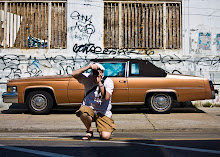The gallery director, Karen Lilly, has done a fantastic job in setting up the show, an exhibit that does a nice job of showing the wide-ranging interests and subjects of West Virginia photographers. Everything from traditional landscapes to digitally manipulated abstracts are represented. Some of my favorite pieces were by Steve Payne, Paul Hartmann, and Paige Dalporto.
Besides the quality of the pieces in the show, I am especially excited about this exhibit since I have more pieces in it than in any other show I've been in. Here are some of the photographs I have on display currently:

This picture is of a traffic mirror I saw in Budapest, Hungary. It was the only photo I took while there that I knew was a keeper.

This photography is why I don't understand people who only take black & white photographs. The colors in this image almost make me ache they are so vibrant and powerful. I really do have a strong physical reaction to this photograph every time I look at it.

This is another example of my fascination with creepy dolls and mannequins. Interestingly, there are many who look at this picture and see the doll as cute or nostalgic. It gives me nightmares, but in a good way.

This might be the photo I've taken that I like the most. Hardly anyone else has liked this image as much as I do, but I feel like I stumbled up this great tableau or still life and really like the composition of the shot. Artistic prerogative I guess.

I found this scene on a beach in Menton, France, and it spoke to me on many subliminal levels. The creepiness of the face mask, reminiscent of a death mask with the broken glass eyes, really begged me to shoot it. I obliged. I like the very limited color palate of the scene as well.

This is a crop of a picture I took of an old manual typewriter. I have taken many pictures of this typewriter, but none I was happier with. The rows of metal arms looking like a row of teeth give the typewriter a real personality.

This scene is from a VW junkyard north of Parkersburg, WV. I was very excited when we stumbled onto the scene and planned to take many, many photos and sort them out later. Unfortunately, the batteries in my camera died about 10 shots into the shoot. I put in my back up batteries and they were already dead. *sigh* I plan to stop again on my next trip to Columbus. I love the colors of the yellow and green bugs, so vibrant next to the rust of the ramshackle hulks.
Please let me know what you think of any of these photos. If you get a chance, be sure to stop at Tamarack too. Thank you and take care.
RAV

